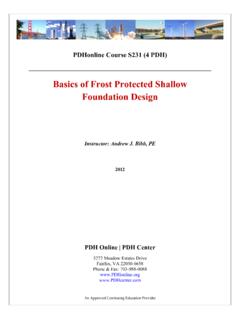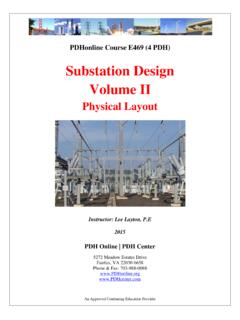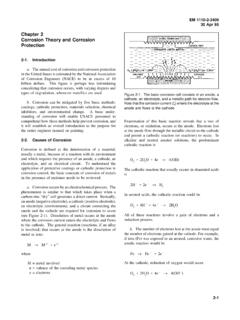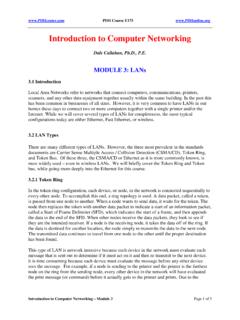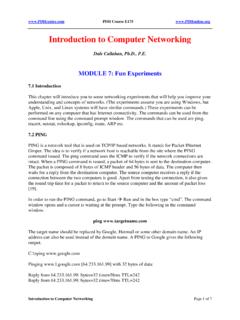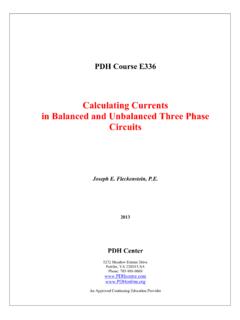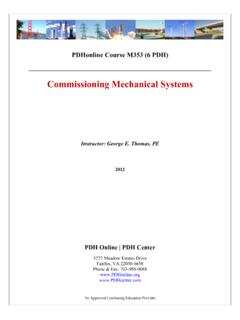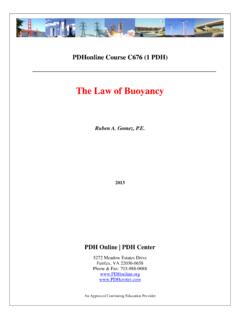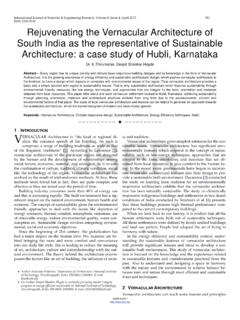Transcription of HVAC Made Easy: A Guide to Heating & Cooling Load …
1 PDHonline Course M196 (4 PDH)HVAC Made Easy: A Guide to Heating & Cooling load Estimation2012 Instructor: A. Bhatia, Online | PDH Center5272 Meadow Estates DriveFairfax, VA 22030-6658 Phone & Fax: Approved Continuing Education PDH Course M196 Page 1 of 79 HVAC Made Easy: A Guide to Heating & Cooling load Estimation Course Content AIR CONDITIONING SYSTEM OVERVIEW Cooling & Heating load calculations are normally made to size HVAC ( Heating , ventilating, and air-conditioning) systems and their components. In principle, the loads are calculated to maintain the indoor design conditions. The first step in any load calculation is to establish the design criteria for the project that involves consideration of the building concept, construction materials, occupancy patterns, density, office equipment, lighting levels, comfort ranges, ventilations and space specific needs.
2 Architects and other design engineers converse at early stages of the project to produce design basis & preliminary architectural drawings. The design basis typically includes information on: 1) Geographical site conditions (latitude, longitude, wind velocity, precipitation etc.) 2) Outdoor design conditions (temperature, humidity etc) 3) Indoor design conditions 4) Building characteristics (materials, size, and shape) 5) Configuration (location, orientation and shading) 6) Operating schedules (lighting, occupancy, and equipment) 7) Additional considerations (type of air-conditioning system, fan energy, fan location, duct heat loss and gain, duct leakage, type and position of air return ) Climate data requirements One of the most important things in building HVAC design is the climate you are designing. Let s make first distinction in terms weather and climate . "Weather" is the set of atmospheric conditions prevailing at a given place and time.
3 "Climate" can be defined as the integration in time of weather conditions, characteristics of a certain geographical location. At the global level climates are formed by the differential solar heat input and the uniform heat emission over the earth's surface. Climate has a major effect on building performance, HVAC design and energy consumption. It is also pertinent to the assessment of thermal comfort of the occupants. The key objectives of climatic design include: 1) To reduce energy cost of a building 2) To use "natural energy" as far as possible instead of mechanical system and power 3) To provide comfortable and healthy environment for people Classification of climates Many different systems of climate classification are in use for different purposes. Climatic zones such as tropical, arid, temperature and cool are commonly found for representing climatic conditions. For the purposes of building design a simple system based on the nature of the thermal problem in the particular location is often used.
4 1) Cold climates, where the main problem is the lack of heat (under Heating ), or excessive heat dissipation for all or most parts of the year. 2) Temperate climates, where there is a seasonal variation between under Heating and overheating, but neither is very severe. 3) Hot-dry (arid) climates, where the main problem is overheating, but the air is dry, so the evaporative Cooling mechanism of the body is not restricted. There is usually a large diurnal (day - night) temperature variation. PDH Course M196 Page 2 of 79 4) warm - humid climates, where the overheating is not as great as in hot-dry areas, but it is aggravated by very high humidity s, restricting the evaporation potential. The diurnal temperature variation is small. Six categories of climates: 1) warm - humid - 15 N and South of the equator, Lagos, Mombassa, Colombo, Jakarta etc.
5 2) warm - humid Island - equatorial and trade wind zones, Caribbean, Philippines and Pacific Islands etc. 3) Hot-dry desert - 15 to 30 North and South, Baghdad, Alice Springs, Phoenix etc. 4) Hot-dry maritime desert - latitudes as (3), coastal large landmass, Kuwait, Karachi etc. 5) Composite Monsoon - Tropic Cancer/Capricorn, Lahore, Mandalay, New Delhi etc. 6) Tropical uplands - Tropic Cancer/Capricorn, 900 to 1200 meters above sea level (plateau and mountains), Addis Ababa, Mexico City, Nairobi etc. load Calculations Methods Before one can design an efficient and effective air conditioning system, the load must first be calculated using established techniques. There are various methods in use. The most basic of these methods is a rule-of-thumb value -- for example, square feet of floor area per ton of Cooling . The "square-foot-per-ton" sizing method avoids calculating the Cooling load of the building and proceeds directly from the square footage of the building.
6 While this approach is rapid and simple, it does not account for orientation of the walls and windows, the difference in surface area between a one-story and a two-story home of the same floor area, the differences in insulation and air leakage between different buildings, the number of occupants, and many other factors. Such rules-of-thumb are useful in schematic design as a means of getting an approximate handle on equipment size and cost. The more refined methods available in the HVAC handbooks are: 1) Total Equivalent Temperature Difference/Time Average (TETD/TA) 2) Cooling load Temperature Difference/ Cooling load Factor (CLTD/CLF) 3) Transfer Function Method (TFM) 4) Heat Balance (HB) & Radiant Time Series (RTS) 5) Manual J Method for Residential Applications & Manual N for Commercial Buildings: These methods are simplified versions, jointly developed by Air conditioning contractors of America (ACCA) and the Air conditioning and Refrigeration Institute (ARI).
7 These different methods may yield different results for the same input data. This is primarily due to the way; each method handles the solar effect and building dynamics. But in true sense all the above approaches attempt to consider the fundamental principle that heat flow rates are not instantaneously converted to loads and heat addition or extraction incident upon the building do not immediately result in a change in temperature. Thermally heavy buildings can effectively delay the Cooling or Heating load for several hours. Most designers use the TETD and CLTD methods because these methods are simple to use, give component loads and tend to predict load on conservative side. The most recent versions of the ASHRAE Fundamentals Handbook (2001) provide more detailed discussion on the Radiant Time Series (RTS) and Heat Balance (HB) methods. The Heat Balance method is the most accurate but is very laborious and cumbersome and is more suitable with the use of computer programs.
8 The RTS is a simplified method derived from heat balance (HB) method and effectively replaces all other simplified (non-heat balanced) methods. For strictly manual Cooling loads calculation method, the most practical to use is the CLTD/CLF method. This course discusses CLTD/CLF method in detail in succeeding sections. A number of handbooks provide a good source of design information and criteria to use for CLTD/CLF method; however engineering judgment is required in the interpretation of various custom tables and applying appropriate correction factors. It is not the intent of this course to duplicate information but rather to provide a direction regarding the proper use or application of the available data so that the engineers and designers can make an appropriate PDH Course M196 Page 3 of 79 PART 1 SUMMER Cooling load Preface The term summer Cooling load means much more than merely Cooling the air in a building.
9 In addition to Cooling the air, it also implies controlling: 1) The relative humidity 2) Providing proper ventilation 3) Filtering out contaminants (air cleaning) and 4) Distributing the conditioned air to the lived-in spaces in proper amounts, without appreciable drafts or objectionable noise This section deals with the design aspects and the equations used for summer Cooling load calculations. Design Conditions The amount of Cooling that has to be accomplished to keep buildings comfortable in hot summer depends on the desired condition indoors and on the outdoor conditions on a given day. These conditions are, respectively, termed the indoor design condition and the outdoor design condition . Indoor Design Conditions The indoor design conditions are directly related to human comfort. Current comfort standards, ASHRAE Standard 55-1992 [4] and ISO Standard 7730 [5], specify a comfort zone, representing the optimal range and combinations of thermal factors (air temperature, radiant temperature, air velocity, humidity) and personal factors (clothing and activity level) with which at least 80% of the building occupants are expected to express satisfaction.
10 As a general guideline for summer air-conditioning design, the thermal comfort chapter of the ASHRAE fundamentals handbook (Chapter 8, 2001) provides a snapshot of the psychrometric chart for the summer and winter comfort zones. For most of the comfort systems, the recommended indoor temperature and relative humidity are: 1) Summer: 73 to 79 F; The load calculations are usually based at 75 F dry bulb temperatures & 50% relative humidity 2) Winter: 70 to 72 F dry bulb temperatures, 20 - 30 % relative humidity The standards were developed for mechanically conditioned buildings typically having overhead air distribution systems designed to maintain uniform temperature and ventilation conditions throughout the occupied space. The Psychrometric chapter of the Fundamentals Handbook (Chapter 6, 2001) provides more details on this aspect. Outdoor Design Conditions Outdoor design conditions are determined from published data for the specific location, based on weather bureau or airport records.

